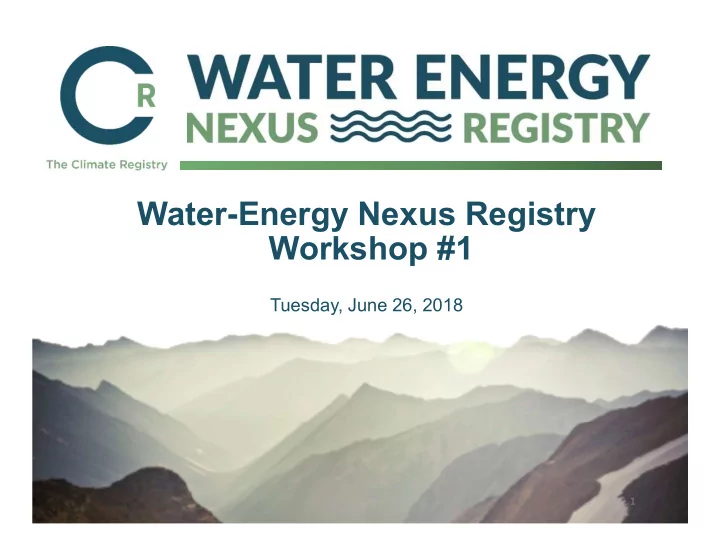

Water-Energy Nexus Registry Workshop #1 Tuesday, June 26, 2018 1
How to Build a Greenhouse Gas Inventory
Introduction Kelli Wright Program Coordinator The Climate Registry
Opening Poll Website Link: Kahoot.it
Carbon Footprint The total amount of greenhouse gases that are emitted into the atmosphere each year by an organization or company, either directly or indirectly.
Greenhouse Gases Carbon dioxide (CO 2 ) Methane (CH 4 ) Nitrous oxide (N 2 O) Hydrofluorocarbons (HFCs) Perfluorocarbons (PFCs) Sulfur hexafluoride (SF 6 ) Nitrogen trifluoride (NF 3 )
Steps to the Reporting Process Identify your reporting boundaries Identify your facilities and sources Identify your facilities and sources Organize and collect data on emission Organize and collect data on emission sources sources Quantify and report emissions Quantify and report emissions
Identify your reporting boundaries Determine which operations, facilities, and sources should be included Things to consider: • Geographic region? • All or some of your facilities? • Which greenhouse gases?
Steps Identify your reporting boundaries Identify your reporting boundaries Identify your facilities and sources Organize and collect data on emission sources Organize and collect data on emission sources Quantify and report emissions Quantify and report emissions
Identify your facilities and sources What is a “facility”? Typically a single physical premise • E.g. office building, water treatment plant, pump station OR, can be aggregation of smaller or distributed emissions sources E.g. vehicle fleet, water distribution • system
Identify your facilities and sources What is a “source”? Physical object or activity that emits greenhouse gas emissions Vehicle combusting gasoline Water boiler combusting natural gas Electricity consumed in buildings Cooling systems leaking refrigerants
Identify your facilities and sources An entity will usually have multiple facilities. A facility can have multiple sources associated with it. Southern California Water Agency ( Entity ) Headquarters Building– LA County ( Facility ) Electricity for lighting, computers, etc. purchased from SCE Boilers – natural gas purchased from SoCal Gas Refrigerators – refrigerant leakage Forklifts – propane
Steps Identify your reporting boundaries Identify your reporting boundaries Identify your facilities and sources Identify your facilities and sources Organize and collect data on emission sources Organize and collect data on emission sources Quantify and report emissions Quantify and report emissions
Organize and collect data on emission sources Where to find data? Electricity or Natural Gas Utility bills Accounting department Utility account managers Fuel (generators, pump equipment, etc.) Bulk fuel purchase records Vehicles Fuel usage logs and mileage records For large organizations, may be tracked in fleet management system (e.g. Voyager)
Organize and collect data on emission sources Data Management Where does my data live? Do I have a good paper trail? Would someone new be able to understand the process?
Organize and collect data on emission sources Scope 1, 2, and 3 Graphic via Greenhouse Gas Protocol - https://ghgprotocol.org/
Scope 1 - Direct Boilers Generators Vehicles Refrigerators
Scope 2 - Indirect Purchased electricity Purchased heating Purchased steam & cooling
Scope 3 –Indirect (Optional) Employee commuting Business travel Upstream and Downstream activities such as waste disposal
Biogenic CO 2 Biogas from wastewater treatment Biodiesel Captured methane from landfills
Steps Identify your reporting boundaries Identify your reporting boundaries Identify your facilities and sources Identify your facilities and sources Organize and collect data on emission sources Organize and collect data on emission sources Quantify and report emissions Quantify and report emissions
Quantify and report emissions Once you have the data, how do you calculate emissions? Activity Data: Emission Factor : quantity of fuel or converts activity = X GHGs material that, when data into amount used, emits GHGs of GHGs e.g. 9.13 kg CO2 e.g. gallons of emitted per one gallon gasoline, SCF of of motor gasoline natural gas, Mwh of combusted electricity
Quantify and report emissions CO 2 / gallon = 913 kg 100 gallons 9.13 kg of gasoline X of CO 2 Activity Data: quantity of Emission Factor : X = fuel or material that, when converts activity data GHGs used, emits GHGs into amount of GHGs
Quantify and report emissions Scope 2 Accounting (Purchased Electricity, Steam, Heat or Cooling) Two accounting methods help clarify renewable energy claims and accounting: Location-based method Market-based method
Quantify and report emissions Location-Based Method Reflects emissions as they occur on the local grid Primarily uses grid- average emission factors I.e. emission factors reflecting emissions profile of power consumed in region Reflects overall fuel/generation mix of power in region
Quantify and report emissions Market-based Method Reflects the GHG emissions associated with choices you make about energy supply or purchase. Allows you to claim the specific emission rate associated with energy purchases Emission factors specific to renewable energy purchases: RECs, PPAs, etc. Utility-specific emission factors
Quantify and report emissions Market-based Method If your organization purchases green power with a specified emissions rate, your organization can generally claim this in the market-based method E.G. utility green power program, community choice aggregator power product
Tracking over Time Setting a Base Year Setting and adjusting a base year provides a standardized benchmark that reflects an organization’s evolving structure Allows changes in organizational structure to be tracked in a meaningful fashion Communicates reduction efforts
Verification A third-party audit of your GHG inventory to confirm that it meets relevant accounting standard (e.g. General Reporting Protocol) and is free of misstatements Ensures quality and integrity of reported data, drives improvements in organizational reporting practices Widely practiced in mandatory and voluntary GHG programs worldwide
Additional Resources TCR’s General Reporting Protocol Page Default Emission Factors Additional guidance like Electric Power Sector Protocol, Local Government Operations Protocol, Small Business Guidance Greenhouse Gas Protocol Global accounting standard in line with TCR’s GRP Additional guidance on Scope 2 methods and Scope 3 accounting
Trivia Website Link: Kahoot.it
Questions? (866) 523-0764 x3 help@theclimateregistry.org
Recommend
More recommend